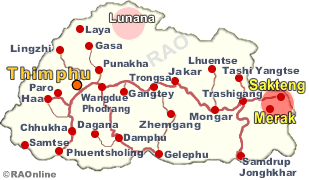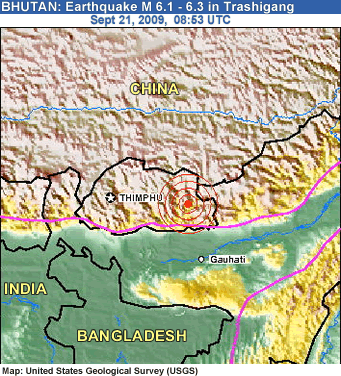|
Bhutan
- Ethnic Groups & People
|
 |
Bhutan's People Merak - Sakten |
|
 |
Bhutan Information |
|
|
 |
|
Sturdy homes of Sakteng
|

|
 |
| While villagers in the east are rebuilding their homes, with scars still afresh in their minds of the devastation the last earthquake left, they still wonder how homes in Sakteng remained intact despite its falling within the epicentre of the quake.
The epicentre of the quake was located along the border of Sakteng gewog and the Indian state of Arunachal Pradesh.
|
|
The semi-nomads of the Brokpa community proudly attributed the way in which they built their two-storied traditional houses for its ability to withstand the impact of the quake.
Most houses in the gewog are built using solid stones, timber and bamboo.
The doors and windows from hardwood are small, firmly fixed into the neatly stacked walls of long slender stones between which a small amount of red mud plaster was applied.
The houses are small and their ceilings are just as low. Zow (carpenter) Wangdi, who has been into carpentry since he was 20, said the walls had to be proportionate in both length and height.
"I built 30 houses and none of them have any damages," he said.
Most homes have only one room with just one or two windows in a storey. A few have two rooms. "That's basically to keep our homes warm," he said.
 |
Earthquake Details
provided by Red Puma (ETH Zurich Switzerland) |
21 Sep 200909:16:55.2
10 mb=4.9 M
GSR BHUTAN1049 |
21 Sep 200908:53:03.3
27.3N91.5E
10 MS=6.3 M
*GSR BHUTAN1026
|
21 Sep 200908:53:05.8
27.2N91.7E
15 mb=5.9 M
*ROM BHUTAN1018 |
21 Sep 200908:53:05.6
27.3N91.4E
7 M =6.3 M
*NEI BHUTAN0905 |
|
Bamboo mats are laid between stonewalls at each interval after a certain height to prevent stones from falling apart. "The bamboos don't rot for a long time, which keeps the stones in place even if the mud in the long run lost its ability to glue the stones," said Wangdi.
The previous wooden shingle roofs are today replaced with CGI sheets provided by Sakteng wildlife sanctuary.
Even government institutions, like the basic health unit, school and natural resource centres, built using similar materials and styles as those in any remote villages were undamaged.
"They were also built using our traditional methods," Wangdi said.
Around five houses, mostly new ones, suffered minor damage.
These houses, local artisans said, used stones from the riverbanks without any dressing. "Most of the new buildings, we can see, used round stones from the banks," Wangdi said.
Dorji Laydra lives with four other members in his house. His two-year-old house suffered slight cracks from the earthquake.
"I suppose there must have been something wrong in the way we built it," he said, adding that he built his house in urgency.
Pemala, a village elder, said their land was blessed to have been spared the wrath of the earthquake.
Village elders also said their building methods was replicated from the Breymi (Tawangpas) just across the border.
The Brokpas resided in bamboo shacks when they first settled in Sakteng. Later artisans from Tawang were hired by the wealthy to build houses for them.
"It was then that our people learnt carpentry and masonry," Sakteng gewog mangap Sangay Dorji said. "The first house was built more than some 70 years back."
Villagers feel their houses would suffer damage should another quake hit the village in future, as more and more villagers dismantled their old houses and built modern ones.
"We pray and hope that that was the last of the earthquake," Wangdi said.
 |
| Contributed
by Tshering Palden, Kuensel, Bhutan's National Newspaper, 2010 |
|
more
information
|

|
|




